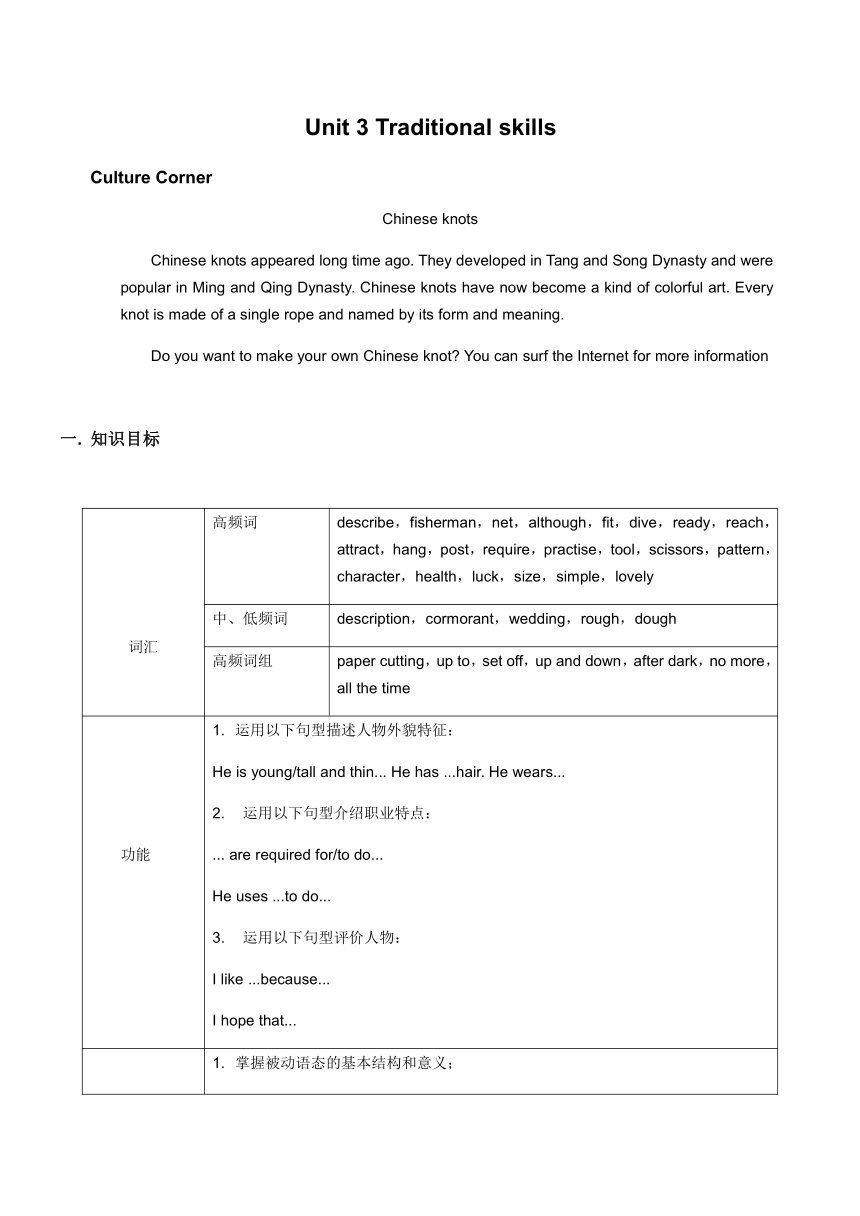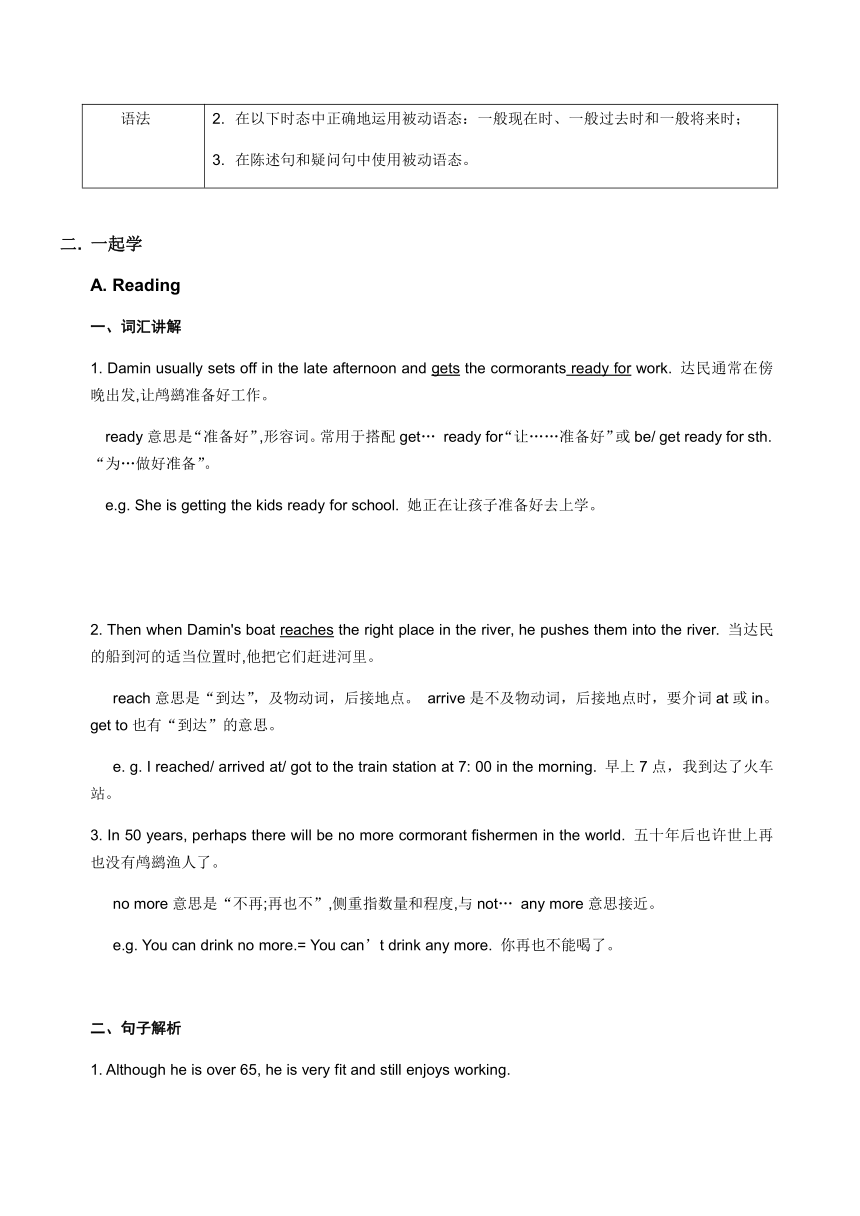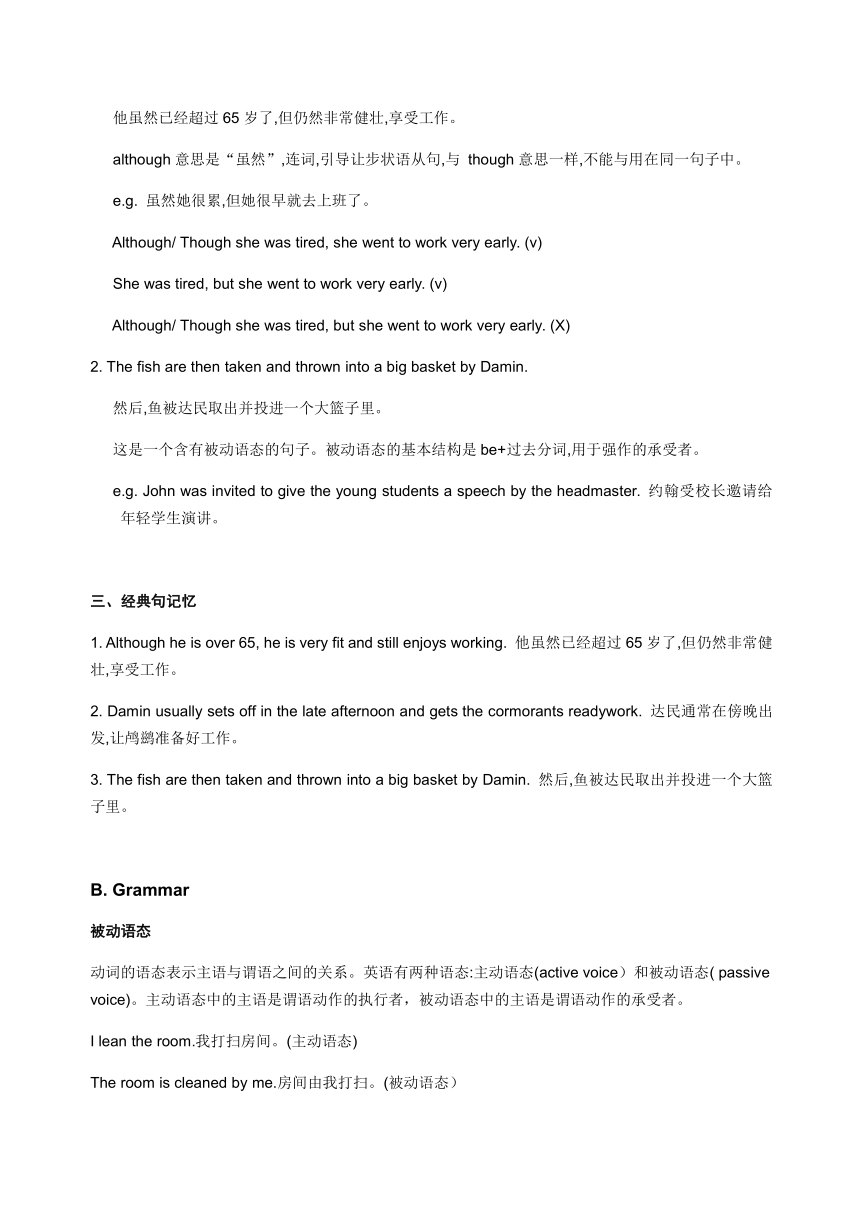牛津深圳版英语八年级下册Module 2 Arts and crafts Unit 3 Traditional skills讲义
文档属性
| 名称 | 牛津深圳版英语八年级下册Module 2 Arts and crafts Unit 3 Traditional skills讲义 |  | |
| 格式 | zip | ||
| 文件大小 | 38.0KB | ||
| 资源类型 | 教案 | ||
| 版本资源 | 牛津深圳版 | ||
| 科目 | 英语 | ||
| 更新时间 | 2020-05-18 11:33:26 | ||
图片预览



文档简介
Unit 3 Traditional skills
Culture Corner
Chinese knots
Chinese knots appeared long time ago. They developed in Tang and Song Dynasty and were popular in Ming and Qing Dynasty. Chinese knots have now become a kind of colorful art. Every knot is made of a single rope and named by its form and meaning.
Do you want to make your own Chinese knot? You can surf the Internet for more information
1. 知识目标
词汇 高频词 describe,fisherman,net,although,fit,dive,ready,reach,attract,hang,post,require,practise,tool,scissors,pattern,character,health,luck,size,simple,lovely
中、低频词 description,cormorant,wedding,rough,dough
高频词组 paper cutting,up to,set off,up and down,after dark,no more,all the time
功能 运用以下句型描述人物外貌特征:He is young/tall and thin... He has ...hair. He wears...运用以下句型介绍职业特点:... are required for/to do...He uses ...to do...运用以下句型评价人物:I like ...because...I hope that...
语法 掌握被动语态的基本结构和意义;在以下时态中正确地运用被动语态:一般现在时、一般过去时和一般将来时;在陈述句和疑问句中使用被动语态。
2. 一起学
A. Reading
一、词汇讲解
1. Damin usually sets off in the late afternoon and gets the cormorants ready for work. 达民通常在傍晚出发,让鸬鹚准备好工作。
ready意思是“准备好”,形容词。常用于搭配get… ready for“让……准备好”或be/ get ready for sth.“为…做好准备”。
e.g. She is getting the kids ready for school. 她正在让孩子准备好去上学。
2. Then when Damin's boat reaches the right place in the river, he pushes them into the river. 当达民的船到河的适当位置时,他把它们赶进河里。
reach意思是“到达”,及物动词,后接地点。 arrive是不及物动词,后接地点时,要介词at或in。get to也有“到达”的意思。
e. g. I reached/ arrived at/ got to the train station at 7: 00 in the morning. 早上7点,我到达了火车站。
3. In 50 years, perhaps there will be no more cormorant fishermen in the world. 五十年后也许世上再也没有鸬鹚渔人了。
no more意思是“不再;再也不”,侧重指数量和程度,与not… any more意思接近。
e.g. You can drink no more.= You can’t drink any more. 你再也不能喝了。
二、句子解析
1. Although he is over 65, he is very fit and still enjoys working.
他虽然已经超过65岁了,但仍然非常健壮,享受工作。
although意思是“虽然”,连词,引导让步状语从句,与 though意思一样,不能与用在同一句子中。
e.g. 虽然她很累,但她很早就去上班了。
Although/ Though she was tired, she went to work very early. (v)
She was tired, but she went to work very early. (v)
Although/ Though she was tired, but she went to work very early. (X)
2. The fish are then taken and thrown into a big basket by Damin.
然后,鱼被达民取出并投进一个大篮子里。
这是一个含有被动语态的句子。被动语态的基本结构是be+过去分词,用于强作的承受者。
e.g. John was invited to give the young students a speech by the headmaster. 约翰受校长邀请给年轻学生演讲。
三、经典句记忆
1. Although he is over 65, he is very fit and still enjoys working. 他虽然已经超过65岁了,但仍然非常健壮,享受工作。
2. Damin usually sets off in the late afternoon and gets the cormorants readywork. 达民通常在傍晚出发,让鸬鹚准备好工作。
3. The fish are then taken and thrown into a big basket by Damin. 然后,鱼被达民取出并投进一个大篮子里。
B. Grammar
被动语态
动词的语态表示主语与谓语之间的关系。英语有两种语态:主动语态(active voice)和被动语态( passive voice)。主动语态中的主语是谓语动作的执行者,被动语态中的主语是谓语动作的承受者。
I lean the room.我打扫房间。(主动语态)
The room is cleaned by me.房间由我打扫。(被动语态)
一、构成
1. The fish are taken and thrown into a big basket by Damin.
2. No nets are required for this type of fishing.
3. Cormorant fishing was once practised in lots of places in South-East China.
4. In a year, a new park will be built near my house.
要点归纳
1. 被动语态的构成:助动词be+过去分词。
2.被动句有各种时态,通过助动词be的变化来体现,be还必须与主语的人称和数量保持一致。
时态 构成 例子
一般现在时 am/ are/is(not)+过去分词 例1: are required例2: are taken and thrown
一般过去时 was/were(not)+过去分词 例3: was practised
一般将来时 will( not) be+过去分词 例4: will be built
3.如果提及谓语动作的执行者,用by短语引出,如例句1。
二、用法
被动语态常用于下列情况:
1. 当我们不知道或不必提及动作的执行者时,如:Look! There is nothing here. Everything is taken away.
看!这里什么都没有。所有东西都被拿走了。
2. 当我们强调或侧重动作的承受者时,如:
The number of the cars is controlled by the government. 车辆的数量受政府控制。
三、应注意的问题
1.通常只有及物动词才能构成被动语态。不及物动词或动词短语 happen, take place,break out 等无被动语态。如:
A terrible traffic accident happened in the early morning. 清晨,一起可怕的交通意外发生了。
2. 有些动词短语在意义上相当于及物动词,能构成被动语态,并应看作不可分割的整体,即不可去掉后面的介词或副词。如:
Grandmother looks after the baby carefully every day.(主动语态) 每天,奶奶悉心地照顾婴儿。
The baby is looked after carefully by grandmother every day.(被动语态) 每天,婴儿由奶奶悉心照顾。
C. Speaking and Writing
一、描述人物
我们通常从年龄、体型、身高、头发及其他特征来描述人的外貌特点。
1. 常用词汇
Age:young,middle-aged,old,aged,elderly,in one’s thirties,a 3-year-old girl
Build:heavy,fat,plump,well built,slim,thin,skinny
Height:tall,short,above/ of average height
Hair/ Other:black/ blond(e)/brown/red/ straight/ long/ short hair, bald,glasses, has a beard/ moustache
2.常用句型
(1) 形容词: She is young/slim/tall
(2) with短语: She is a young girl with long hair
二、写的策略指导
当我们写人,描述他的外貌特征和介绍他的职业特点时,可以考虑以下几个方面:
1. 列提纲,确定短文的段落内容。
Paragraph I 描述人物的外貌特征。
Paragraph 2 介绍人物的职业,可以从工作工具或工作步骤入手。
Paragraph 3 你对这个人物和他的职业技能的评价。
2. 时态的使用。介绍人物时多用一般现在时。如果文中提及人物过往的经历过去时。
3. 常用表达
(1) 介绍工作工具: be required for/to do,use...to do, be used to do
(2) 介绍工作步骤: First…Then...
(3) 给出看法或评价:I like…, because…, I hope that...
D. More Practice
一、词汇讲解
1. Every Saturday, Wang Weifang puts on a play with his friends in a small town Xi’an. 每周六,王维方和他的朋友在西安附近的一个小镇演戏。
put on在本句中的意思是“上演;展出”。它还有“穿,戴”的意思。
e.g. Our school drama club will put on a new play this Friday. 本周五,我们学校的戏剧社将要演出一个新剧。
Hurry up! Put your coat on. 快点!把外套穿上。
2. Shadow puppets are made of hard leather. 皮影人偶是由硬皮革做成的。
be made of意思是“用……做成”,后接可看得出原材料的名词。如果看不出原页用 be made from。
e.g. All our furniture is made of wood. 我们的家具都是用木头做成的。
Paper is made from wood. 纸是用木材做的。
二、句子分析
Now with TV and films, shadow puppet plays are not as popular as before.
现在,随着电视和电影的出现,皮影戏不像以前那样受欢迎了。
with在本句的意思是“与(某物)同时,随着”。as...as意思是“与……一样,否定形式: not so/as…as,往往可译为“不够……”。
e.g. He is not as tall as his twin brother. 他不够他的孪生兄弟高。
三、经典句记忆
1. That is because they are putting on a shadow puppet play. 那是因为他们正在演出皮影戏。
2. Now with TV and films, shadow puppet plays are not as popular as before. 现在,随着电视和电影的出现,皮影戏不像以前那样受欢迎了。
3. They want to keep this traditional art form alive. 他们想让这种传统艺术形式传承下去。
同课章节目录
